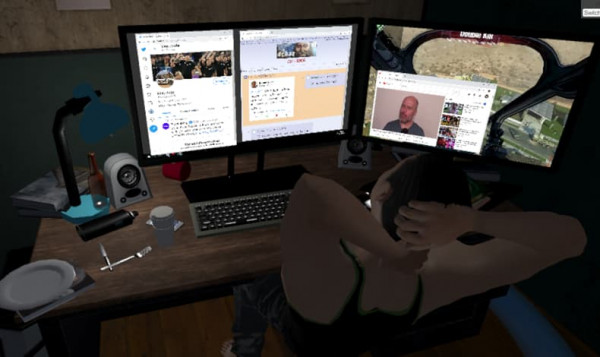With the rise in new technologies, especially social media platforms, it’s never been easier to communicate at scale with our fellow human beings.
Using virtual reality to explore online hate speech
With the rise in new technologies, especially social media platforms, it’s never been easier to communicate at scale with our fellow human beings.
Back in the heady days at the birth of the internet, online communication began as polite exchanges, bad websites and cat memes. But, in today’s online world, politeness has been replaced with confrontation. Now, we have snowflakes, flamewars, doxing and industrialised outrage.
What we consider to be socially acceptable standards of behaviour in real life — for example, not shouting abuse in someone’s face — has become a grey area when we head online. With anonymity and the ‘safety’ of a screen between us, it appears our in-real-life (IRL) social norms no longer apply.
The Service Innovation’s Emerging Tech team worked together with our Digital Rights and Ethics colleagues at the Department of Internal Affairs (DIA) to understand how technology — in this case, virtual reality (VR) — might be applied to explore the challenges of ‘online social norms’.
The project focussed on the cause-and-effect chains of online hate speech.
Why online hate speech as a focus?
Online hate is a pressing issue. Eleven per cent of New Zealand adults report they have been targeted with online hate speech. Six in 10 of those targeted reported a negative impact from the experience, with most reporting being affected emotionally and also exhibiting behaviour changes in areas like their social interactions, sleep and work.
Read the full report: Online Hate Speech (2018), NetSafe (PDF 792KB).
Creation of VR tool
We developed a VR tool called the Online Social Norms VR, an experience that gives us a sense of how the public service may begin to use near-future technologies as a research strategy to inform policy development for complex social issues.
In this project, the tool allowed senior leaders and analysts to see and understand:
- the drivers and impacts of online hate speech
- how the application of near-future technologies, such as VR, can support future policy development to be better informed by evidence-led, contextual experiences.

Detailed description of image
Screenshot of Sean, a VR character who perpetrates online hate speech, sitting in front of 2 computer screens displaying several social media streams and internet chat forums
Why use VR?
VR is a highly immersive technology, placing the participant in a 3-dimensional physical space inside the story.
In VR, you assume the point of view of a character in the story, experiencing what they see and hear without the screen as mediator. This is a very different physical and emotional experience from exploring a scenario via a 2-dimensional screen.
For a topic such as online hate speech, where screens provide a safety barrier to perpetrators, using VR is a means to break the fourth wall and get inside an experience.
The Online Social Norms VR story
Video transcript
[Visual — Main view]
3D-rendered view of a young Pākehā man called Sean sitting at his computer desk in a dark bedroom. He has his back to us and is looking at 2 computer monitors on a desk. His desk is messy and dimly lit with a small desk lamp. There are 2 small speakers, a cup, a beer bottle, a mobile phone, a clipboard and a bag of chippies scattered over the desk. There is a noticeboard on the wall. His room is messy, his bed unmade and there are boxes scattered on the floor. There is a small side table and a bookshelf, and a guitar is propped up against the wall beneath an ‘All Blacks’ poster.
[Visual — Smaller inset]
Video of woman wearing a VR headset and headphones and using hand controllers. She is moving her head to look around a small collaborative workroom. The room has a large whiteboard with writing all over it and the workspace walls are covered with Post-it Notes. There is a large video screen which is playing back the 3D environment that we can see in the main view and that the woman sees through her headset.
[Audio]
Semi-automatic guns continually firing and male voice commentary of radicalised ideas about race.
[Narrator]
Our VR Online Social Norms prototype allows users to follow a segment of online hate speech experienced from different perspectives:
[Visual — Main view]
The young Pākehā man, Sean, throws his arms up in the air as he is looking at the computer screens. He seems agitated. The first screen shows multiple message windows. The second screen shows a first-person shooter game and a YouTube video of a middle-aged man speaking to camera. Sean types some text into the chat message field on his screen. The message says ‘This is some very bad text that people shouldn’t really be posting online but they do for a variety of reasons, like we’ve seen in the research’. The message is sent. This message is displayed in an online forum from ‘KiwiDude’.
[Visual: Smaller inset]
The woman in the video slowly turns her head to look around Sean’s bedroom, which she can see through the VR headset. The view on the main screen matches the direction of her gaze.
[Audio]
Semi-automatic guns continually firing and male voice commentary of radicalised ideas about race.
[Narrator]
Those of a hate-speech perpetrator, immersed in an online world of streaming content, governed by the influence of algorithms, their voice and actions mediated, shared and amplified through our online public spaces, particularly social media.
[Visual — Main view]
A West African man called John is sitting in his living room looking at his mobile phone. The room has attractive floral patterned wallpaper and there is a painting of a solitary cottage in the mountains and a large mirror on the walls. The room is comfortably furnished with a lounge suite, colourful cushions, side tables, pot plants and a large screen TV with speakers. There are lamps in the corners of the room. On the coffee table are some mugs and a teapot. The room looks out onto a small garden and neighbouring houses.
[Visual — Smaller inset]
The woman in the video continues to move around the collaborative workspace, now using her headset to explore John’s sitting room. She appears to pick up something with her controller. At exactly the same time, the avatar, John, in the large video screen picks up his mobile phone and looks at the messages on the screen.
[Audio]
Birds tweeting and commentary of football game with crowd cheering.
[Narrator]
And a hate-speech recipient — where online delivery mechanisms enable hate speech to be targeted into a private physical space, where the effects are suffered without direct means of redress.
[Visual — Main view]
A close up of John’s mobile phone shows chat messages that display in a similar way to on Twitter. An instruction appears beside the phone for the female participant in the UX story that says ‘Scroll’. In amongst the nice messages on the mobile phone there is one message that reads ‘This is some very bad text that people shouldn’t really be posting online but they do for a variety of reasons, like we’ve seen in the research’. John types a response to the message that says: ‘This is my reply to the hate speech. It is not acceptable.’ John reads some message responses and then puts the phone down on a side table.
[Visual — Smaller inset]
The woman in the video wearing a VR headset continues to slowly turn her head to look around.
[Audio]
Birds tweeting and commentary of football game with crowd cheering.
[Narrator]
Our intent for this prototype is as a tool to:
- reveal the cause-and-effect chains behind online hate speech
- recognise the situations of both recipients and perpetrators, and
- explore how new online social norms can be developed, making hate speech unacceptable.
When you use the Online Social Norms VR tool, you experience the story from 2 perspectives. The first perspective is through Sean’s social media online hate bubble. The second perspective is through John’s impacted family life.
We meet John at home, where he responds to a random, hateful tweet. We follow John’s tweet as it enters Sean’s online world. Egged on by 4Chan (an online bulletin board where anyone can post comments and share images anonymously), Sean sends hate-filled tweets, which are then escalated by online forums, resulting in John becoming a social media hate target.
Keeping our staff safe
During the project, the team managed the risks around being exposed to the VR tool’s hate speech component by:
- following a set of operational protocols to keep themselves safe, and
- choosing not to include real hate-speech examples in the first cycle of prototype development.
The protocols were formalised in a health and safety plan, which all team members signed.
The team also created an ethics plan as a guide to making sure ethical risks in a project are considered and justifiable, and that measures are put in place to manage these.
There are two versions of the tool. The first uses substitute speech to imply hate speech is being used. The second uses hate speech drawn from real examples – this version requires users to sign a consent form before proceeding.
Sharing the tool
With project development now complete, we have been inviting interested participants from across government to experience the VR tool.
Initially, this began as a tool for senior leaders to engage with a challenging topic. The initiative was driven by the Digital Rights and Ethics team, part of the Government Chief Digital Officer’s (GCDO) office at DIA.
The project has now been presented and shared internationally as part of New Zealand’s contributions to the Digital Nations group, a collaborative network of the world’s leading digital governments.
Try the VR tool
We are now inviting interested individuals and community groups to engage with the work. To support this, we have made the project open source on GitHub:
Digital Social Norms VR tool – GitHub
Get started
The project has been developed using the Unity 3d game engine, which is free to install.
You’ll need an HTC Vive VR rig to run the environment, and a Steam VR account, also free.
The project is available on our GitHub for you to download and run, and includes all the Getting Started information you need to know.
We have provided a VR simulator option, if you want to take a look without running in full VR.
We also provide a pre-built download version that’s ready to run on our Releases page. These files are zipped and need unpacking before use.
What happens next
Using VR was an opportunity to explore this new technology in a government setting. It has helped us understand what the future of public service delivery will be.
VR falls in the category of technology called Spatial Computing. As this technology advances over the next 10 years, we’ll move away from screen and keyboard-based experiences and engage with online digital interactions in an environment that is more natural for humans — using natural body motion like hand gestures and by speaking, not typing.
Read more about the Online Social Norms VR project
VR: The challenge of creating a story arc in immersive experiences


